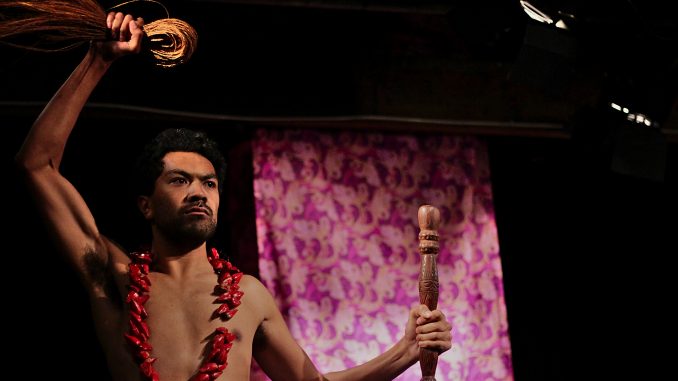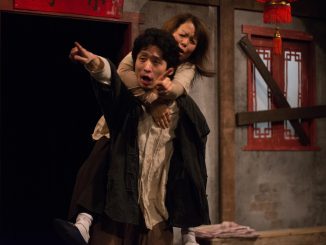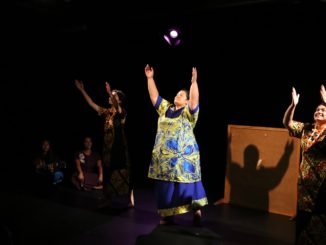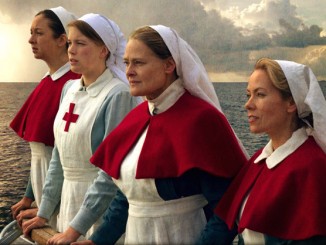
[Welcomed to the Fale] by Gabriel Faatau’uu Satiu
Under the direction of Aleni Tufuga (also translated by him in gagana Sāmoa), O Nofoa serves as one part of Te Pou’s multilingual season of Eugene Ionesco’s play The Chairs. The show is an absurdist tragic farce. Paying homage to Ionesco’s absurdity through the deliberate nonsense and broadly stylized performance, the timing of the physical comedy exceeds the bar.
There are seven pillars in the room each draped in different ie lavalava colours and patterns. Two chairs are placed side-by-side stage-right. The lighting design is very minimal, but through the warmth on stage (and probably the heat I feel from the front row), I’m immediately taken back to my grandparents’ home in Sāmoa. The vibrant colours of the pillars remind me of old family photos, Sāmoan decor, flowers, shells, tarpaulins and fine mats which are often found in Sāmoan fales.
Faamanu Vaueli plays the Old Man, wearing only black and is dressed in an ie fai taga and an unbuttoned shirt, revealing his bare chest. Petmal Petelo Lam is genderfluid and plays the character of the Old Woman. Her hair is wild and doesn’t look well maintained but is held together by a comb. Her outfit is a plain top with an ie lavalava wrapped around her waist. The costuming is simple but reminds me of my grandparents, and my parents (and myself) in the comfort of home.
The comedic timing of both Vaueli and Lam is next-level, which also imbuing the characters with layers so other facets are also highlighted. As a Sāmoan I appreciate the complexity of both of these multidimensional characters. Often our Pacific people have been portrayed as stereotypical and one-dimensional. The relationship between this couple is realistic and sincere and I believe that both actors are a real life couple in love. Again, I am reminded of both my grandparents as the stress rises between the Old Man and Woman as numerous chairs are brought onto the stage as “guests” arrive in preparation of the tulafale.
One layer of absurdity is found in the amount of (non-matching) chairs that are placed on stage. And the comedy is in the stress and rising tension of the chair placement. The couple are overwhelmed with guests that there is a shortage of chairs. So they use other forms of chairs like a bench, a fala (mat) and even a step-ladder. The audience roar in laughter at the insanity and chaotic chair placement. Finally, the tulafale (Aisea Latu) steps out, contradicting the entire setup of the play and adding next-level absurdity.
After the show I stay back to celebrate, have some food on offer and talanoa with other audience members about the show. Interesting discussions were had with fellow reviewer Camilla Walker and other non-Sāmoan audience members. Their views on this interpretation of Ionesco’s work is an example of how absurdity reaches across generations and cultures. There is also a unanimous feeling about how exciting it is for our people to hear and watch a show that is presented in 100% gagana Sāmoa. And it makes me extensively proud to be of Sāmoan descent but also be reminded that there is so much of the language I am yet to understand. I congratulate the director and the team for the amazing work. I also thank Te Pou for creating an atmosphere allowing a multilingual season of the absurdist tragic farce; I hope that it is the first of many.
[Seated Laughter] by Camilla Walker
Te Pou’s fascinating multilingual season of Ionesco’s The Chairs continues this week with O Nofoa in gagana Sāmoa. Directed and translated by Aleni Tufuga, this is another uproariously enjoyable night of theatre for both Sāmoan speakers and those, like me, who understand none of the Samoan language. We are given a generously comedic, touching and witty show.
O Nofoa is minimalistic in design, but the warmth and clarity of Chez Marama’s lighting design, the colourful nature of the characters’ clothing, and bold patterning of the Sāmoan fabric hangings all reflect the zesty personalities of the Old Man (Faamanu Vaueli) and Old Woman (Petmal Petelo Lam). The couple have a strong sense of connection, and a clear love for one another comes through in this adaptation. There’s a tenderness in their body language and a softness between them vocally that somehow didn’t feature quite so much in the Te Reo Māori adaptation, and almost hardly at all in the Pākehā version.
Now having seen three renditions of the same play, it becomes difficult not to view certain choices in context of knowing other versions of the play, and then extrapolate that they reveal cultural differences. Made in the spirit of respect and curiosity, however, I don’t think such reflections are to be shied away from – quite the contrary, because the point of this quadruple season of The Chairs was in the very first place to encourage intercultural experience, reflection and celebration of difference.
In that spirit, it really struck me in O Nofoa that the energy of the old couple came across as much calmer and less frenetic than did the mad scramblings of the Pākehā man and his wife, or even the more agitated assertions of the Māori koro and kuia.
Franticness is not part of their physicality – their movement ranges from languid and relaxed, through seemingly unfazed activity, and then, when the need for more chairs leads to more urgency, great comedy comes from the fact that there is no middle ground between low energy chair shuffling to explosively high energy chair-throwing (yet with no visibly faster pace of walking, and no real loss of composure).
The large audience’s infectious laughter gave rise to the feeling that moments like these perhaps carried greater significance than mere stage comedy or physical jokes, but that they were actually documenting recogniseable habits or the tendencies belonging to a culture. Of course, that may well be a projection on my part, but there was an atmosphere of palpable delight in the audience’s laughter that felt like the joy of recognition, and it was great fun to feel part of that. Yet again, the experience of a foreign language felt much more inclusive than might be expected.
The close bond between this couple endures throughout the play, especially once they move from their original spots on two downstage chairs, where they spend perhaps the first third to half of the play. The fact they don’t seem to need to be anywhere but with each other, and to have nothing else to do but sit together, seems to be the reason holding them in their seats. This again may well be down to cultural reasons, and entirely fitting to this interpretation, but from a purely dramatic perspective, it might have been rewarding to see these loveable characters move and communicate in a more physically fluid way earlier in the show. That said, it’s a joy when they do get up to start greeting their visitors and we instantly start to see into their characters with greater depth through watching how they move.
Their movement once they start moving around more is witty, well-timed, expressive of character, and intrinsically captivating to watch for its comic rewards. As a first-time director, Tufuga has done a great job in creating a buoyant, funny, and vivacious rendition of The Chairs. Music also works effectively in service of atmosphere, and makes for a very entertaining sex scene.
Performances from Faanamu Vaueli and Petmal Petelo Lam are tender, generous, and strongly connected by an ease with one another that is hugely watchable. Judging by the packed audience on opening night, it’s exciting to see that this looks like possibly the most popular rendition of The Chairs yet.
O Nofoa – The Chairs – Sāmoan Season plays at Te Pou until 28 July.




Leave a Reply